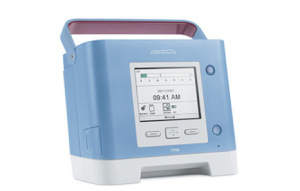Philips study shows noninvasive home ventilation can reduce COPD readmissions
by
John W. Mitchell, Senior Correspondent | April 25, 2017

Philips Trilogy 100
Patients suffering a common, often deadly, respiratory condition who went home from the hospital supported by more technologically advanced noninvasive ventilation (NIV) were less likely to be readmitted to the hospital — resulting in cost savings of nearly half a million dollars over 90 days — according to a study published in the journal Value in Health.
The study, sponsored by Philips, calculated the cost savings based on the home use of its advanced Trilogy 100 portable ventilator with AVAPS-AE mode on 250 patients with severe chronic obstructive pulmonary disease (COPD) following their discharge from the hospital. This was compared to patients who did not receive advanced care NIV treatments or did not receive NIV treatment at all.
"Noninvasive ventilation (NIV) assists patients with their breathing by providing a prescribed pressure or volume of air during inhalation," Dr. Teofilo Lee-Chiong, Chief Medical Liaison for Philips and professor of medicine at National Jewish Hospital and the University of Colorado, told HCB News. "Newer technologies, such as the AVAPS-AE mode used in the study with Philips Trilogy, are more responsive to the patient's ever-changing breathing needs."
The study determined a $402,981 savings over 30 days and $449,101 savings over 90 days for 250 patients. Further, in a related payor base case analysis of 100,000 patients, the study calculated a three-year savings of $326 million for patients treated with the advanced care NIV and $1.04 billion in savings compared to no NIV treatment.
According to Lee-Chiong, AVAPS-AE, or automated mode, continuously adjusts respiratory pressure to clinical targets best for the individual patient. This, he said, increases patient comfort, as it matches up with an individual's breathing pattern.
COPD is one of the most common, yet most under-diagnosed diseases in the world, according to Philips. It affects 384 million people worldwide and is the third leading cause of death in the U.S.
Morbidity aside, COPD is one of the leading contributors to rising health care costs due to inpatient hospital admissions. It's estimated that the health economic burden of COPD will reach $50 billion by 2020.
"We wanted to assess whether a comprehensive strategy of care, including the use of newer, more advanced noninvasive ventilators, can reduce the economic burden of managing patients with moderate-to-severe COPD," said Lee-Chiong.
He said that NIV is a proven protocol to improve survival rates, enhance quality of life and reduce hospital readmissions. Philips believed developing an NIV-automated delivery approach individualized to each patient would offer further improvements for patients and help control health care spending.
"I believe that science and imagination will continue to create novel technologies that improve quality of life, prolong survival, and allow patients with COPD to live their fullest lives," said Lee-Chiong.
|
|
|
You Must Be Logged In To Post A Comment
|
